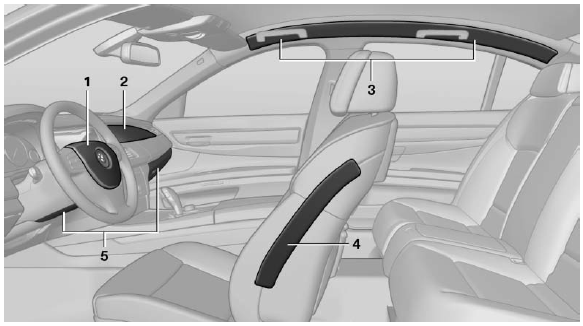Airbags
 1 1 Front airbag, driver
1 1 Front airbag, driver
2 Front airbag, front passenger
3 Head airbag
4 Side airbag
5 Knee airbags
Front airbags
Front airbags help protect the driver and front passenger by responding to frontal impacts in which safety belts alone cannot provide adequate restraint.
Side airbags
In a lateral impact, the side airbag supports the side of the body in the chest and lap area. In a lateral impact, the side airbag supports the side of the body in the chest, lap, and head area.
Head airbags
In a lateral impact, the head airbag supports the head.
Knee airbag
The knee airbag supports the legs in a frontal impact.
Protective action
Airbags are not triggered in every impact situation, e.g., in less severe accidents or rear-end collisions.
Information on how to ensure the optimal protective effect of the airbags
- Keep at a distance from the airbags.
- Always grasp the steering wheel on the steering wheel rim, holding your hands at the 3 o'clock and 9 o'clock positions, to keep the danger of injury to your hands or arms as low as possible if the airbag is triggered.
- There should be no people, animals, or objects between an airbag and a person.
- Do not use the cover of the front airbag on the front passenger side as a storage area.
- Keep the dashboard and window on the front passenger side clear, i.e., do not cover with adhesive labels or coverings, and do not attach holders such as for navigation instruments and mobile phones.
- Make sure that the front passenger is sitting correctly, i.e., keeps his or her feet and legs in the footwell; otherwise, leg injuries can occur if the front airbag is triggered.
- Do not place slip covers, seat cushions or other objects on the front passenger seat that are not approved specifically for seats with integrated side airbags.
- Do not hang pieces of clothing, such as jackets, over the backrests.
- Make sure that occupants keep their heads away from the side airbag and do not rest against the head airbag; otherwise, injuries can occur if the airbags are triggered.
- Do not remove the airbag restraint system.
- Do not remove the steering wheel.
- Do not apply adhesive materials to the airbag cover panels, cover them or modify them in any way.
- Never modify either the individual components or the wiring in the airbag system. This also applies to steering wheel covers, the dashboard, the seats, the roof pillars and the sides of the headliner.
Even when all instructions are followed closely, injury from contact with the airbags cannot be ruled out in certain situations.
The ignition and inflation noise may lead to short-term and, in most cases, temporary hearing impairment in sensitive individuals.
![]() In the case of a malfunction, deactivation
and after triggering of the airbags
In the case of a malfunction, deactivation
and after triggering of the airbags
Do not touch the individual components immediately after the system has been triggered; otherwise, there is the danger of burns.
Only have the airbags checked, repaired or dismantled and the airbag generator scrapped by your service center or a workshop that has the necessary authorization for handling explosives.
Non-professional attempts to service the system could lead to failure in an emergency or undesired triggering of the airbag, either of which could result in injury.
Warnings and information on the airbags are also found on the sun visors.
See also:
Engine and differential
Always obey the official speed limit.
Up to 1,200 miles/2,000 km
Do not exceed the maximum engine and road
speed:
▷ For gasoline engine, 4,500 rpm and
100 mph/160 km/h.
Avoid full-thrott ...
The Inside
The X3's redesigned interior continues the sparse, minimalistic design
approach that BMW favors, but it does a better job of integrating the center
screen, which serves as the display for the stan ...
Replacing the batteries
No rechargeable batteries
Do not use rechargeable batteries, as
damage may result from the substances in the
batteries.
1. Remove the cover. Press on the cover, arrow
1, and push forward, ...
